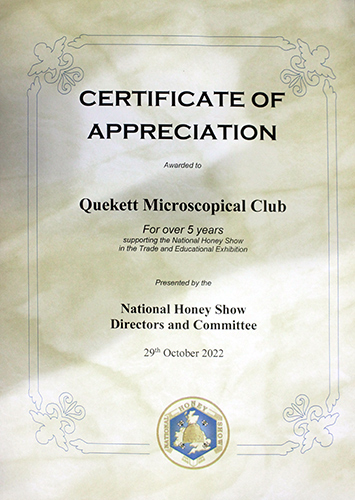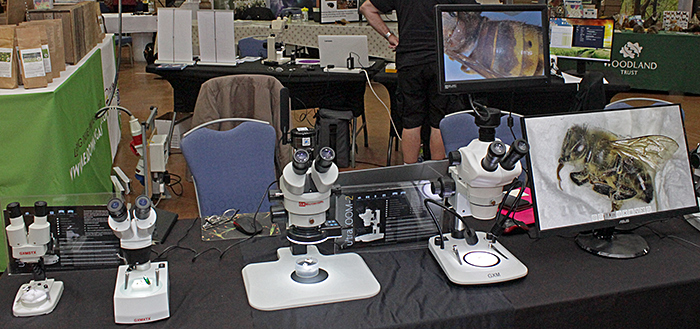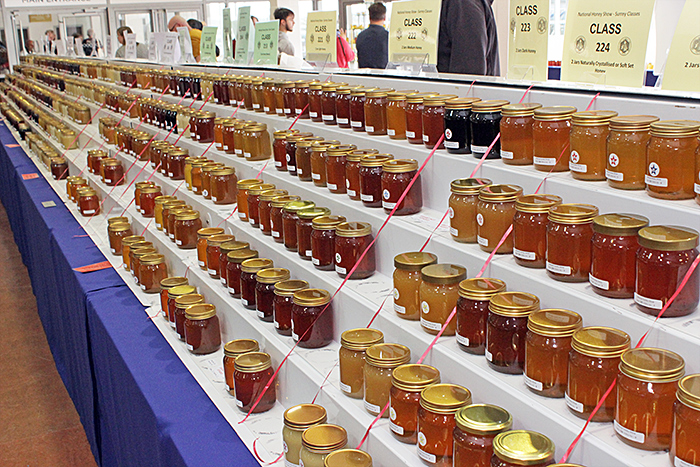National Honey Show
Thursday 27th to Saturday 29th October 2022
This was our ninth visit to the National Honey Show, held this year at Sandown Park Racecourse in Esher in Surrey, which has become a regular part of our microscopy outreach programme.
Paul Smith and Alan Wood manned the Club’s stand in the Trade Hall, which is adjacent to the area where all of the entries for the Show are displayed. We had a good selection of specimens, microscopes and leaflets on the stand, and plenty of space for our displays and for visitors. We also had a laptop computer with rolling PowerPoint presentations.
 Paul Smith with a visitor
Paul Smith with a visitor
Paul brought his monocular Wild M11 compound microscope fitted with an eyepiece camera and his Philip Harris stereomicroscope that has a digital camera built in. Both cameras were connected to a tiny Acer Revo computer, controlled by the Window 10 Camera app and displaying images on a monitor. Paul brought some pollen slides that he had made, and we also had sets of pollen and bee parts from Brunel Microscopes, a set of pollen slides by N.B.S., and some slides by Eric Impey.
 Paul Smith’s microscopes
Paul Smith’s microscopes
Alan brought his Olympus SZ4045 stereomicroscope fitted with a 144 LED ring light so that visitors could admire a set honeybee. Alan also brought his laptop and used it for a PowerPoint slide show with nearly 100 photomicrographs of honeybee anatomy, parasites and pollen taken by members of the Quekett and the Postal Microscopical Society.
 Alan Wood’s microscope
Alan Wood’s microscope
Slide show: Honeybee anatomy, parasites and pollen
Click the arrows to move through the slides. Click the symbol at bottom right for a larger version.
On the first day, we were surprised by the number of children among the visitors, so for the next 2 days we added a small stereomicroscope (the STX Stereo Microscope sold on Amazon by GT Vision) and the Natural History Museum Pocket Microscope.
 Microscopes for children
Microscopes for children
We had some interesting conversations with visitors, often explaining the pros and cons of compound microscopes (high magnification, good for slides, but small working distance) and stereo microscopes (large working distance, good for dissecting honeybees, but low magnification). Several people asked about taking photographs through a microscope, and we explained that it can be done with a smartphone, a C-mount camera, an eyepiece camera, a point-and-shoot camera, a mirrorless camera or a digital SLR. Our younger visitors did not ask this question, they just held their smartphones above the eyepiece of one of our microscopes. We handed out lots of copies our free “getting started” and “things to look at” leaflets, and we hope to see some of the visitors at our Zoom gossip meetings and lectures.
GT Vision donated a compound microscope that was raffled to raise funds for the National Honey Show, and we displayed a poster and sold raffle tickets. We also sold copies of Norman Chapman’s book “Pollen Microscopy”, which contains over 200 of his drawings of pollen, made by tracing photomicrographs.
The Club thanks Val Rhenius (the Publicity Secretary and Trade Hall Booking Secretary) for organising our stand at this impressive and well-organised event. We were honoured to receive a Certificate of Appreciation from Bob Maurer (Chairman of the Show) for our ongoing support.
 Certificate of Appreciation
Certificate of Appreciation
Our stand backed on to the GT Vision stand, an arrangement that worked very well. Ian Baldwin (their Sales Director) and his colleagues were demonstrating a wide range of stereo and compound microscopes, some of them fitted with C-mount cameras and displaying good images on monitors.
 Ian Baldwin (left) with visitors
Ian Baldwin (left) with visitors
 Compound microscopes from GT Vision
Compound microscopes from GT Vision
 Stereomicroscopes from GT Vision
Stereomicroscopes from GT Vision
Honey Show
The Show was in the same area as the Trade Hall, but cordoned off until Thursday afternoon while the judging was taking place.
The slides that had been submitted for the Show were displayed on a light box, with a couple of microscopes for a closer look. The entries looked much better than in previous years.
 Slides and microscopes
Slides and microscopes
 Microscope slides
Microscope slides
There were lots of candles and other fairly simple items made of beeswax, but there were also some amazing flowers made of beeswax.
 Beeswax flowers
Beeswax flowers
Other entry classes included embroidery, such as this honeybee.
 Embroidered honeybee
Embroidered honeybee
As usual, there were hundreds of bottles of mead (an alcoholic drink made from honey, yeast and water), displayed so that their colour could be assessed.
 Bottles of mead for judging
Bottles of mead for judging
And, of course, thousands of jars of honey from large and small producers, all using the same style of jar.
 Jars of honey for judging
Jars of honey for judging
There is even a category for the labels of honey jars.
 Honey labels for judging
Honey labels for judging
Trade Hall
In addition to the Quekett and GT Vision stands, there were lots of stands in the Trade Hall where members of the public could buy almost anything a beekeeper could desire, browse books on bees, find out about associations to join, learn about beekeeping in developing countries and learn about pests and diseases of bees.
Meadow In My Garden sells a range of award-winning flower meadow seed products designed to foster a wildlife-friendly environment, and gives talks and seminars for horticultural clubs, beekeepers groups, garden shows, festivals, green events, civic societies, colleges and schools. They had a small stereomicroscope for looking at seeds.
The National Bee Unit is part of the Animal & Plant Health Agency, which works to safeguard animal and plant health for the benefit of people, the environment and the economy. They are involved in the management and control of bee pests and diseases, along with training and dissemination of information to beekeepers. At the Show they were offering advice on problems such as the small hive beetle (Aethina tumida), European foulbrood, parasitic Tropilaelaps mites, the Asian hornet (Vespa velutina) and Varroa mites.
The Woodland Trust is a charity that plants woods and trees, restores damaged ancient woodlands, saves woods and trees from destruction, and cares for over 1000 woods. They work with farmers, landowners and local communities to create bigger, better, more resilient landscapes across the U.K. for people and wildlife.
Claire Murthy is an artist who paints, illustrates and writes about the wildlife and pets that live in and around the garden, countryside and woods. Bees feature in several of her works.
Grans on the Make raise money for charity through their obsession with knitting and crochet. They showed lots of bee-related items that they have made, and were giving away instructions that are also available on their website.
Northern Bee Books were selling an amazing number of new books on honeybees, and a good selection of used books.
BeeCraft not only publish the magazine of the same name, they also publish books, including “Practical Microscopy for Beekeepers” by Bob Maurer.
Bees Abroad is a charity that works directly with communities and in-country partners to provide training in local beekeeping best practices, business skills, and protecting the environment.
Bees for Development is a charity that makes life better with bees. They promote sustainable beekeeping to combat poverty, build resilient livelihoods and benefit biodiversity.
There were also stands selling beehives, protective clothing, jar fillers and probably everything else that a beekeeper could want.
The next National Honey Show will be held at Sandown Park Racecourse from Thursday 26th to Saturday 29th October 2023, and we are planning to be there again.
Report and photographs by Alan Wood













